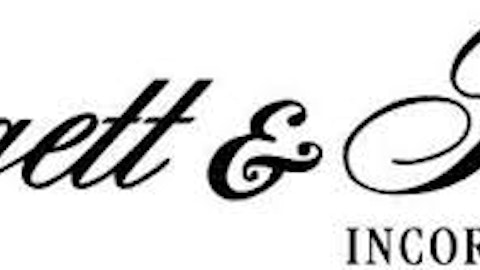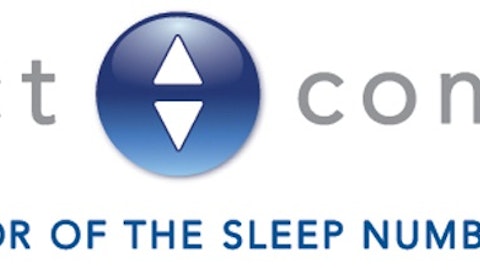Leggett & Platt, Inc. (NYSE:LEG) was founded in 1883. Here’s some other notable events form 1883:
– Time zones were created
– Krakatoa volcano erupted
– Buffalo Bill created his Buffalo Bill Wild West Show
Much has changed in the world since 1883, but Leggett & Platt is still around. The company has a market cap of nearly $6 billion today.
Leggett & Platt’s primary business is spring and coil mattress manufacturing. People need mattresses today just as much as they did in 1883.
Leggett & Platt registered a considerable boost in popularity among the funds tracked by Insider Monkey, with 23 investors reporting long positions as of the end of September, compared to 12 funds with stakes in the company a quarter earlier. Overall, these funds amassed 2.40% of Leggett & Platt’s outstanding stock. David Harding, Jim Simons, and Israel Englander are among the investors who initiated substantial positions in the company during the third quarter.
Leggett & Platt Sector & Business Summary
Leggett & Platt operates under four distinct business segments:
– Residential: 48% of total 2014 revenues
– Specialized: 22% of total 2014 revenues
– Industrial: 18% of total 2014 revenues
– Commercial: 12% of total 2014 revenues
The business units in each segment are detailed in the image below from Leggett & Platt’s November 2015 Company Update (slide 22):
Leggett & Platt Stock Dividend History
Leggett & Platt’s large presence in a slow changing industry has allowed the company to increase its dividend payments for 44 consecutive years.
The image below shows the company’s dividend history since 1989 (the first full year of dividend data for the company on Yahoo! Finance).
When I last analyzed Leggett & Platt, the company had increased dividends for 43 years. In August of 2015, the company increased its dividend a modest 3.2% to make 44 consecutive years of dividend increases.
Competitive Advantage
Leggett & Platt manufactures and sells the majority of its products in the United States.
84 out of 133 of the company’s manufacturing facilities are located in the United States.
Source: 2014 Annual Report, page 18
Follow Leggett & Platt Inc (NYSE:LEG)
Follow Leggett & Platt Inc (NYSE:LEG)
Leggett & Platt has a competitive advantage in spring mattress manufacturing and related industries – specifically in the United States.
Mattresses have high transportation costs because of their bulk. This gives local manufacturers a pricing edge over foreign competition.
The bulkiness of mattresses has preserved Leggett & Platt’s spring based mattress competitive advantage in the US despite more economical manufacturing overseas.
Bleak Historical Growth at Leggett & Platt
Mattresses are a slow changing industry, but material science advances have changed the industry over the last decade.
Leggett & Platt, Inc. (NYSE:LEG) has not kept pace with changing trends – despite holding over 1,200 patents and trademarks.
Memory foam mattresses have eroded the company’s growth in the United States. Additionally, cheaper international manufacturing has damaged the company’s position in home and office furniture.
The result – profit in 2005 was higher than 2014 profits.
Despite weak long-term trends, management expects to grow revenue at 4% to 5% annually. To their credit, revenue has grown since the recession of 2007 to 2009.
The company expects to generate a compound annual growth rate for shareholders of between 9% and 13% per year from the following sources:
– Revenue growth (4% to 5%)
– Margin growth (0% to 3%)
– Dividend yield (3% )
– Share repurchases (~2%)
Given tepid historical growth, I find these total return estimates to be closer to management’s dreams (too much time on the company’s mattresses?) than to reality.
I believe the company can generate long-term returns of 4% to 9% for shareholders from the following sources:
– Revenue growth (-1% to 1%)
– Margin growth (0% to 3%)
– Dividend yield (3% )
– Share repurchases (~2%)
These numbers are based on expected continued margin improvements, share repurchases, and dividend payments. Revenue growth was adjusted downward (versus management expectations) to reflect the reality of the company’s growth over the last decade.
Recession Performance
Unlike many other recession resistant Dividend Aristocrats, Leggett & Platt did not perform well through the Great Recession of 2007 to 2009.
The company’s earnings-per-share from 2006 to 2010 are shown below to show how the recession impacted Leggett & Platt:
– 2006 earnings-per-share of $1.57
– 2007 earnings-per-share of $0.28
– 2008 earnings-per-share of $0.73
– 2009 earnings-per-share of $0.74
– 2010 earnings-per-share of $1.15
Leggett & Platt maintained a payout ratio of greater than 100% from 2007 through 2009. If a protracted recession occurs it is unlikely Leggett & Platt will be able to maintain its dividend payments.
To management’s credit, they did prioritize the dividend to avoid a cut.
The company performs poorly during recessions because it sells products that consumers can ‘wait on’ until their economic situation improves. As a result, earnings drop precipitously as the company has a difficult time moving its inventory.
Leggett & Platt Stock Rating
Ratings for Leggett & Platt stock from several analysts are below:
– The Street: A- rating
– AmigoBulls: 3.1 out of 5.0
– Raymond James: Outperform
– JP Morgan Chase: Overweight
The stock is not covered widely, but analyst seem to be somewhat bullish on the stock (I am not).
Leggett & Platt, Inc. (NYSE:LEG) ranks poorly using The 8 Rules of Dividend Investing. Relevant statistics for the company’s stock are shown below, including ranking versus all 182 stocks with 25+ years of dividend payments without a reduction:
– 2.9% dividend yield (ranked 73 out of 182)
– 3.5% expected growth rate (ranked 127 out of 182)
– 31% stock price standard deviation (ranked 110 out of 182)
– Price-to-earnings ratio of 20.6 (ranked 113 out of 182)
Leggett & Platt has an above average dividend yield – but doesn’t stand out well in other categories including: value (price-to-earnings ratio), safety (stock price standard deviation), and growth (expected growth rate).
Based on its mediocre-at-best growth prospects combined with a fairly high price-to-earning ratio, Leggett & Platt is not a buy at current prices.
The company may have a long history, but there are many other companies in the consumer goods sector I’d select ahead of Leggett & Platt. A few examples are below:
– General Mills (GIS)
– Procter & Gamble (PG)
Disclosure: None










